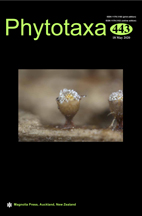Abstract
Foliicolous lichens grow on the surface of living leaves in tropical and subtropical forests. Compared to a large number of species of foliicolous lichens reported from other regions in tropical and subtropical Asia, only six species of the otherwise abundant genus Strigula have been registered from South Korea so far. Three of these, morphologically identified as S. concreta, S. macrocarpa, and S. smaragdula, had previously been shown to share near-identical ITS sequences, casting doubt about the usefulness of this marker for species delimitation in the genus Strigula. To shed light on this conundrum, we surveyed the diversity of the genus Strigula in the Gotjawal forest area on Jeju Island south of mainland Korea, where the climate and vegetation are suitable for foliicolous lichens. As the result of a combined analysis of phenotype and molecular data of the ITS fungal barcoding marker, we found that material morphologically similar to known species formed two strongly supported clades, representing two species new to science, S. depressa Woo, Lücking & Hur sp. nov. and S. multiformis Woo, Lücking & Hur sp. nov., which are described herein. Strigula multiformis included the four previously sequenced specimens identified as S. concreta, S. macrocarpa, and S. smaragdula. A detailed analysis of morphological and anatomical characters revealed that all specimens of S. multiformis were anatomically uniform but varied in thallus morphology, mostly resembling S. smaragdula but with some forms similar to S. concreta and S. macrocarpa, explaining the previous misidentifications. This variation was found to be driven by leaf characters of the phorophyte species, as these apparently influence the morphology of the subcuticular thalli.

